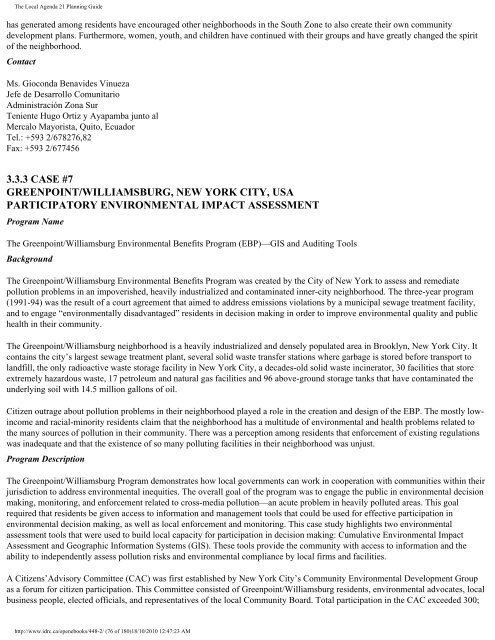The Local Agenda 21 Planning Guide - Democrats Against UN ...
The Local Agenda 21 Planning Guide - Democrats Against UN ...
The Local Agenda 21 Planning Guide - Democrats Against UN ...
You also want an ePaper? Increase the reach of your titles
YUMPU automatically turns print PDFs into web optimized ePapers that Google loves.
<strong>The</strong> <strong>Local</strong> <strong>Agenda</strong> <strong>21</strong> <strong>Planning</strong> <strong>Guide</strong><br />
has generated among residents have encouraged other neighborhoods in the South Zone to also create their own community<br />
development plans. Furthermore, women, youth, and children have continued with their groups and have greatly changed the spirit<br />
of the neighborhood.<br />
Contact<br />
Ms. Gioconda Benavides Vinueza<br />
Jefe de Desarrollo Comunitario<br />
Administración Zona Sur<br />
Teniente Hugo Ortiz y Ayapamba junto al<br />
Mercalo Mayorista, Quito, Ecuador<br />
Tel.: +593 2/678276,82<br />
Fax: +593 2/677456<br />
3.3.3 CASE #7<br />
GREENPOINT/WILLIAMSBURG, NEW YORK CITY, USA<br />
PARTICIPATORY ENVIRONMENTAL IMPACT ASSESSMENT<br />
Program Name<br />
<strong>The</strong> Greenpoint/Williamsburg Environmental Benefits Program (EBP)—GIS and Auditing Tools<br />
Background<br />
<strong>The</strong> Greenpoint/Williamsburg Environmental Benefits Program was created by the City of New York to assess and remediate<br />
pollution problems in an impoverished, heavily industrialized and contaminated inner-city neighborhood. <strong>The</strong> three-year program<br />
(1991-94) was the result of a court agreement that aimed to address emissions violations by a municipal sewage treatment facility,<br />
and to engage “environmentally disadvantaged” residents in decision making in order to improve environmental quality and public<br />
health in their community.<br />
<strong>The</strong> Greenpoint/Williamsburg neighborhood is a heavily industrialized and densely populated area in Brooklyn, New York City. It<br />
contains the city’s largest sewage treatment plant, several solid waste transfer stations where garbage is stored before transport to<br />
landfill, the only radioactive waste storage facility in New York City, a decades-old solid waste incinerator, 30 facilities that store<br />
extremely hazardous waste, 17 petroleum and natural gas facilities and 96 above-ground storage tanks that have contaminated the<br />
underlying soil with 14.5 million gallons of oil.<br />
Citizen outrage about pollution problems in their neighborhood played a role in the creation and design of the EBP. <strong>The</strong> mostly lowincome<br />
and racial-minority residents claim that the neighborhood has a multitude of environmental and health problems related to<br />
the many sources of pollution in their community. <strong>The</strong>re was a perception among residents that enforcement of existing regulations<br />
was inadequate and that the existence of so many polluting facilities in their neighborhood was unjust.<br />
Program Description<br />
<strong>The</strong> Greenpoint/Williamsburg Program demonstrates how local governments can work in cooperation with communities within their<br />
jurisdiction to address environmental inequities. <strong>The</strong> overall goal of the program was to engage the public in environmental decision<br />
making, monitoring, and enforcement related to cross-media pollution—an acute problem in heavily polluted areas. This goal<br />
required that residents be given access to information and management tools that could be used for effective participation in<br />
environmental decision making, as well as local enforcement and monitoring. This case study highlights two environmental<br />
assessment tools that were used to build local capacity for participation in decision making: Cumulative Environmental Impact<br />
Assessment and Geographic Information Systems (GIS). <strong>The</strong>se tools provide the community with access to information and the<br />
ability to independently assess pollution risks and environmental compliance by local firms and facilities.<br />
A Citizens’Advisory Committee (CAC) was first established by New York City’s Community Environmental Development Group<br />
as a forum for citizen participation. This Committee consisted of Greenpoint/Williamsburg residents, environmental advocates, local<br />
business people, elected officials, and representatives of the local Community Board. Total participation in the CAC exceeded 300;<br />
http://www.idrc.ca/openebooks/448-2/ (76 of 180)18/10/2010 12:47:23 AM










